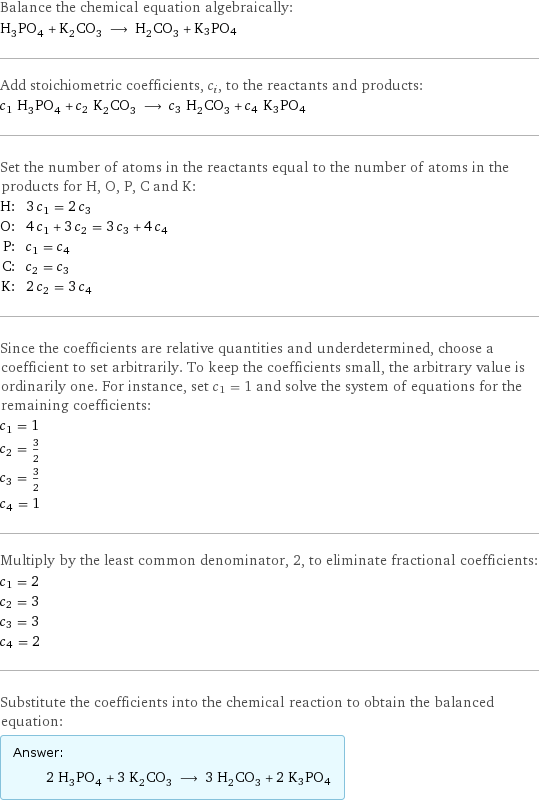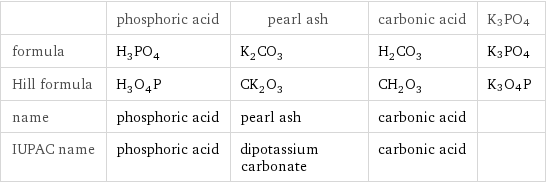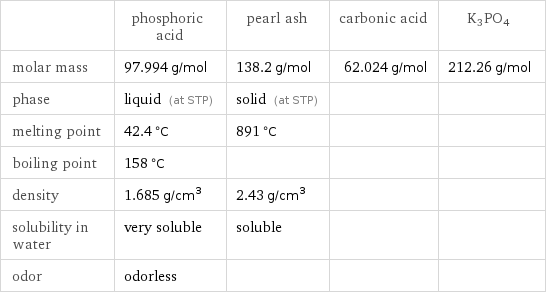Input interpretation

H_3PO_4 phosphoric acid + K_2CO_3 pearl ash ⟶ H_2CO_3 carbonic acid + K3PO4
Balanced equation

Balance the chemical equation algebraically: H_3PO_4 + K_2CO_3 ⟶ H_2CO_3 + K3PO4 Add stoichiometric coefficients, c_i, to the reactants and products: c_1 H_3PO_4 + c_2 K_2CO_3 ⟶ c_3 H_2CO_3 + c_4 K3PO4 Set the number of atoms in the reactants equal to the number of atoms in the products for H, O, P, C and K: H: | 3 c_1 = 2 c_3 O: | 4 c_1 + 3 c_2 = 3 c_3 + 4 c_4 P: | c_1 = c_4 C: | c_2 = c_3 K: | 2 c_2 = 3 c_4 Since the coefficients are relative quantities and underdetermined, choose a coefficient to set arbitrarily. To keep the coefficients small, the arbitrary value is ordinarily one. For instance, set c_1 = 1 and solve the system of equations for the remaining coefficients: c_1 = 1 c_2 = 3/2 c_3 = 3/2 c_4 = 1 Multiply by the least common denominator, 2, to eliminate fractional coefficients: c_1 = 2 c_2 = 3 c_3 = 3 c_4 = 2 Substitute the coefficients into the chemical reaction to obtain the balanced equation: Answer: | | 2 H_3PO_4 + 3 K_2CO_3 ⟶ 3 H_2CO_3 + 2 K3PO4
Structures

+ ⟶ + K3PO4
Names

phosphoric acid + pearl ash ⟶ carbonic acid + K3PO4
Equilibrium constant
![Construct the equilibrium constant, K, expression for: H_3PO_4 + K_2CO_3 ⟶ H_2CO_3 + K3PO4 Plan: • Balance the chemical equation. • Determine the stoichiometric numbers. • Assemble the activity expression for each chemical species. • Use the activity expressions to build the equilibrium constant expression. Write the balanced chemical equation: 2 H_3PO_4 + 3 K_2CO_3 ⟶ 3 H_2CO_3 + 2 K3PO4 Assign stoichiometric numbers, ν_i, using the stoichiometric coefficients, c_i, from the balanced chemical equation in the following manner: ν_i = -c_i for reactants and ν_i = c_i for products: chemical species | c_i | ν_i H_3PO_4 | 2 | -2 K_2CO_3 | 3 | -3 H_2CO_3 | 3 | 3 K3PO4 | 2 | 2 Assemble the activity expressions accounting for the state of matter and ν_i: chemical species | c_i | ν_i | activity expression H_3PO_4 | 2 | -2 | ([H3PO4])^(-2) K_2CO_3 | 3 | -3 | ([K2CO3])^(-3) H_2CO_3 | 3 | 3 | ([H2CO3])^3 K3PO4 | 2 | 2 | ([K3PO4])^2 The equilibrium constant symbol in the concentration basis is: K_c Mulitply the activity expressions to arrive at the K_c expression: Answer: | | K_c = ([H3PO4])^(-2) ([K2CO3])^(-3) ([H2CO3])^3 ([K3PO4])^2 = (([H2CO3])^3 ([K3PO4])^2)/(([H3PO4])^2 ([K2CO3])^3)](../image_source/6f1842d3d845f08d1dbcb33d30fd7a15.png)
Construct the equilibrium constant, K, expression for: H_3PO_4 + K_2CO_3 ⟶ H_2CO_3 + K3PO4 Plan: • Balance the chemical equation. • Determine the stoichiometric numbers. • Assemble the activity expression for each chemical species. • Use the activity expressions to build the equilibrium constant expression. Write the balanced chemical equation: 2 H_3PO_4 + 3 K_2CO_3 ⟶ 3 H_2CO_3 + 2 K3PO4 Assign stoichiometric numbers, ν_i, using the stoichiometric coefficients, c_i, from the balanced chemical equation in the following manner: ν_i = -c_i for reactants and ν_i = c_i for products: chemical species | c_i | ν_i H_3PO_4 | 2 | -2 K_2CO_3 | 3 | -3 H_2CO_3 | 3 | 3 K3PO4 | 2 | 2 Assemble the activity expressions accounting for the state of matter and ν_i: chemical species | c_i | ν_i | activity expression H_3PO_4 | 2 | -2 | ([H3PO4])^(-2) K_2CO_3 | 3 | -3 | ([K2CO3])^(-3) H_2CO_3 | 3 | 3 | ([H2CO3])^3 K3PO4 | 2 | 2 | ([K3PO4])^2 The equilibrium constant symbol in the concentration basis is: K_c Mulitply the activity expressions to arrive at the K_c expression: Answer: | | K_c = ([H3PO4])^(-2) ([K2CO3])^(-3) ([H2CO3])^3 ([K3PO4])^2 = (([H2CO3])^3 ([K3PO4])^2)/(([H3PO4])^2 ([K2CO3])^3)
Rate of reaction
![Construct the rate of reaction expression for: H_3PO_4 + K_2CO_3 ⟶ H_2CO_3 + K3PO4 Plan: • Balance the chemical equation. • Determine the stoichiometric numbers. • Assemble the rate term for each chemical species. • Write the rate of reaction expression. Write the balanced chemical equation: 2 H_3PO_4 + 3 K_2CO_3 ⟶ 3 H_2CO_3 + 2 K3PO4 Assign stoichiometric numbers, ν_i, using the stoichiometric coefficients, c_i, from the balanced chemical equation in the following manner: ν_i = -c_i for reactants and ν_i = c_i for products: chemical species | c_i | ν_i H_3PO_4 | 2 | -2 K_2CO_3 | 3 | -3 H_2CO_3 | 3 | 3 K3PO4 | 2 | 2 The rate term for each chemical species, B_i, is 1/ν_i(Δ[B_i])/(Δt) where [B_i] is the amount concentration and t is time: chemical species | c_i | ν_i | rate term H_3PO_4 | 2 | -2 | -1/2 (Δ[H3PO4])/(Δt) K_2CO_3 | 3 | -3 | -1/3 (Δ[K2CO3])/(Δt) H_2CO_3 | 3 | 3 | 1/3 (Δ[H2CO3])/(Δt) K3PO4 | 2 | 2 | 1/2 (Δ[K3PO4])/(Δt) (for infinitesimal rate of change, replace Δ with d) Set the rate terms equal to each other to arrive at the rate expression: Answer: | | rate = -1/2 (Δ[H3PO4])/(Δt) = -1/3 (Δ[K2CO3])/(Δt) = 1/3 (Δ[H2CO3])/(Δt) = 1/2 (Δ[K3PO4])/(Δt) (assuming constant volume and no accumulation of intermediates or side products)](../image_source/46b92c984058c71e3430bfffc0dd5d0a.png)
Construct the rate of reaction expression for: H_3PO_4 + K_2CO_3 ⟶ H_2CO_3 + K3PO4 Plan: • Balance the chemical equation. • Determine the stoichiometric numbers. • Assemble the rate term for each chemical species. • Write the rate of reaction expression. Write the balanced chemical equation: 2 H_3PO_4 + 3 K_2CO_3 ⟶ 3 H_2CO_3 + 2 K3PO4 Assign stoichiometric numbers, ν_i, using the stoichiometric coefficients, c_i, from the balanced chemical equation in the following manner: ν_i = -c_i for reactants and ν_i = c_i for products: chemical species | c_i | ν_i H_3PO_4 | 2 | -2 K_2CO_3 | 3 | -3 H_2CO_3 | 3 | 3 K3PO4 | 2 | 2 The rate term for each chemical species, B_i, is 1/ν_i(Δ[B_i])/(Δt) where [B_i] is the amount concentration and t is time: chemical species | c_i | ν_i | rate term H_3PO_4 | 2 | -2 | -1/2 (Δ[H3PO4])/(Δt) K_2CO_3 | 3 | -3 | -1/3 (Δ[K2CO3])/(Δt) H_2CO_3 | 3 | 3 | 1/3 (Δ[H2CO3])/(Δt) K3PO4 | 2 | 2 | 1/2 (Δ[K3PO4])/(Δt) (for infinitesimal rate of change, replace Δ with d) Set the rate terms equal to each other to arrive at the rate expression: Answer: | | rate = -1/2 (Δ[H3PO4])/(Δt) = -1/3 (Δ[K2CO3])/(Δt) = 1/3 (Δ[H2CO3])/(Δt) = 1/2 (Δ[K3PO4])/(Δt) (assuming constant volume and no accumulation of intermediates or side products)
Chemical names and formulas

| phosphoric acid | pearl ash | carbonic acid | K3PO4 formula | H_3PO_4 | K_2CO_3 | H_2CO_3 | K3PO4 Hill formula | H_3O_4P | CK_2O_3 | CH_2O_3 | K3O4P name | phosphoric acid | pearl ash | carbonic acid | IUPAC name | phosphoric acid | dipotassium carbonate | carbonic acid |
Substance properties

| phosphoric acid | pearl ash | carbonic acid | K3PO4 molar mass | 97.994 g/mol | 138.2 g/mol | 62.024 g/mol | 212.26 g/mol phase | liquid (at STP) | solid (at STP) | | melting point | 42.4 °C | 891 °C | | boiling point | 158 °C | | | density | 1.685 g/cm^3 | 2.43 g/cm^3 | | solubility in water | very soluble | soluble | | odor | odorless | | |
Units
